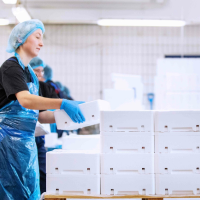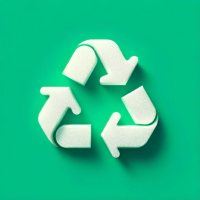Unveiling EPS's Role in Environmental Packaging Solutions
Expanded Polystyrene (EPS) plays a crucial role in safeguarding our food and agricultural sustainability across Europe. Striking the perfect balance between environmental responsibility and practical innovation, EPS packaging solutions, notably fish boxes and beehives, are pivotal in reducing waste, preserving freshness, and enhancing the circular economy. With success stories spanning from the fisheries of the Netherlands to the fields of Denmark, EPS demonstrates its invaluable contribution to food security, waste minimization, and ecological diversity.
EPS Fish Boxes: Helping the Environment in More than Just One Way
 Everyone enjoys some fresh fish every now and then. And everyone agrees that it’s tragic to waste fish or any other fresh foods while other people in the world go hungry. EPS is part of the solution.
Everyone enjoys some fresh fish every now and then. And everyone agrees that it’s tragic to waste fish or any other fresh foods while other people in the world go hungry. EPS is part of the solution.
EPS fish boxes are the market-leading solution for the protection of fish and other seafood products from sea to sales counter across Europe thanks to their unrivalled combination of thermal performance, impact protection, stacking strength and proven eco-credentials. Not only that but since EPS is 100% recyclable, these boxes can be infinitely recycled and put to good use. There are several innovative programmes across Europe to promote the reuse and recycling of EPS fish boxes in ports and fish markets.
In the Netherlands, for example, approximately 90% of fish boxes are recycled. This is due to the determination of Stybenex, the Dutch National Association of Manufacturers of EPS products, which has been initiating and supporting schemes for optimal EPS recycling. The video here shows how the Dutch do it.
EPS fish boxes, like so many other EPS applications, are not only sustainable because they protect and keep fish fresh. The fact that they are almost endlessly recyclable also contributes to the circular economy and avoidance of waste in the environment.
Fish boxes are not the only example in the Netherlands. Hundreds of municipal collection points take back EPS post-consumer waste and EPS packaging collection trends have been showing a steady increase, too.
Reusing and Recycling EPS: Denmark Shows the Way
 The three R’s of the circular economy are Reduce, Re-use and Recycle. A food delivery service in Denmark has achieved outstanding results in re-use and recycling rates with EPS food boxes.
The three R’s of the circular economy are Reduce, Re-use and Recycle. A food delivery service in Denmark has achieved outstanding results in re-use and recycling rates with EPS food boxes.
Food delivery service RetNemt Måltidskasser offers ready-made, high-quality, mostly vegetarian meal boxes for people who don’t have time to cook full meals every day. It offers a variety of different menus and size options. Yet they all have one thing in common: they are delivered in EPS (“Flamingo”) boxes packed with ice that can keep the produce fresh for up to four days.
Moreover, the company collects the boxes with the next delivery, then cleans, disinfects and re-uses them as many times as they can. When the boxes can no longer be used because of damage, they are granulated and sold to a local insulation company (yes, EPS also makes good insulation for buildings, helping to reduce their carbon footprint!).
Overall, Denmark is a leader in plastics recycling, in part thanks to a design guide published by the industry that offers a step-by-step decision tree to help companies pick the most appropriate materials and recycling processes for their packaging. It is estimated that 70% of Danish EPS food delivery service packaging is recycled.
So EPS protects the objects that it transports, keeps them fresh thanks to its second-to-none insulating properties, helps avoid food waste, and after a long life as re-usable packaging, it gets recycled into its second life as insulation that helps Denmark’s houses and office buildings cut their carbon footprints. That’s pretty smart packaging.
What do Bees call Home Sweet Home? Sometimes it’s EPS!
 Bees are by far our planet’s principal pollinators, fertilising plants of all types. But bees face daily challenges to survive and have been dying in greater numbers recently because of external pressures including parasitic mites, habitat loss and harsh weather. Very cold winters can be even more deadly than pests and pesticides. Bees consume nectar produced in the summer to keep the brood warm in the winter. Hot summers can also stress the colony as bees expend energy to try to cool the hive down.
Bees are by far our planet’s principal pollinators, fertilising plants of all types. But bees face daily challenges to survive and have been dying in greater numbers recently because of external pressures including parasitic mites, habitat loss and harsh weather. Very cold winters can be even more deadly than pests and pesticides. Bees consume nectar produced in the summer to keep the brood warm in the winter. Hot summers can also stress the colony as bees expend energy to try to cool the hive down.
Super-insulating EPS beehives help keep bees warmer in the winter and cooler in the summer so they require less food to survive and can spend more time doing what they do best: making honey. That’s good for biodiversity and good for honey producers alike. Food-grade, high-density EPS beehives are also highly resistant to moisture, which prevents the spread of mould which is common with wooden beehives, so they can last 15 years or more.
Beekeepers of all ages also like the fact that EPS beehives are lightweight, making them easier to move—an important feature for professional beekeepers who move hives from one field to the next in season to pollinate crops.
EPS beehives have been used in Europe for more than 40 years. You can read more about them here.
